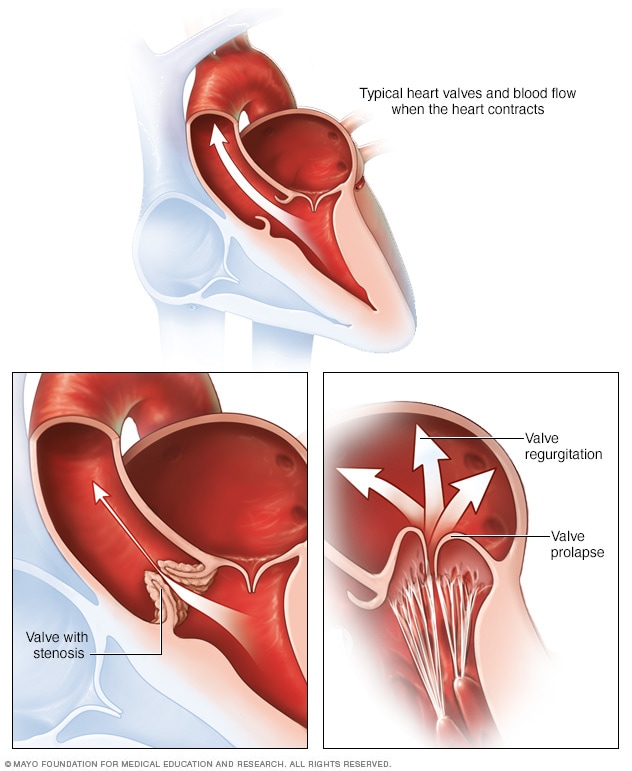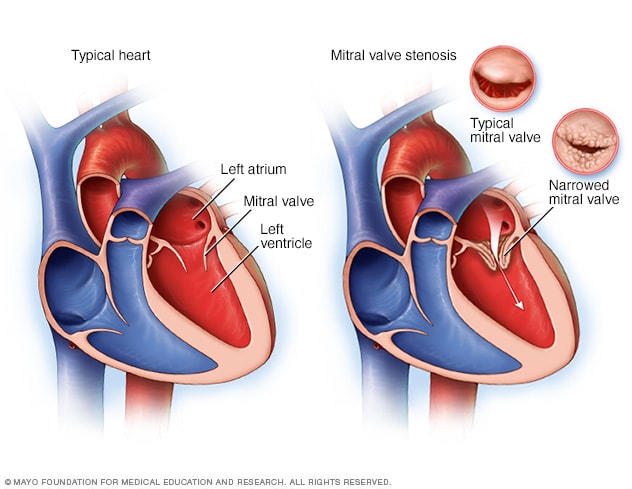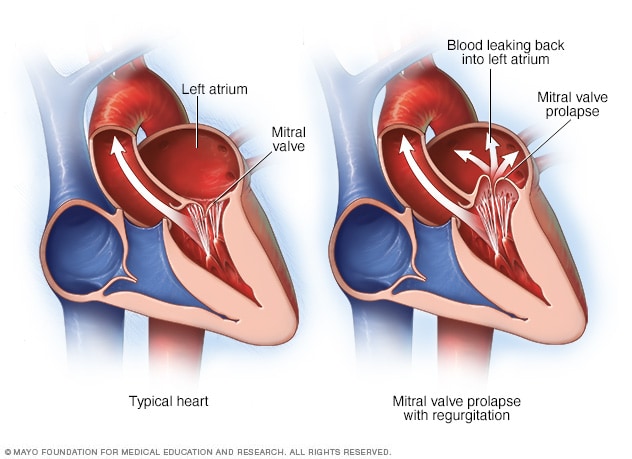Anomalías congénitas de la válvula mitral
Las anomalías congénitas de la válvula mitral son tipos de enfermedades de las válvulas cardíacas que están presentes al nacer. Eso significa que son defectos cardíacos congénitos. Estas afecciones alteran la válvula que se encuentra entre la cavidad superior izquierda y la cavidad inferior izquierda del corazón. Esa válvula se conoce como válvula mitral.
Las anomalías de la válvula mitral incluyen las siguientes:
- Hojuelas gruesas o rígidas de la válvula.
- Hojuelas que están unidas o fusionadas.
- Hojuelas demasiado largas.
- Hojuelas con espacios entre ellas.
- Cambios en las cuerdas que sostienen la válvula. Esto podría incluir cuerdas faltantes, cuerdas cortas y gruesas o cuerdas demasiado largas.
- Más de una apertura en el área de la válvula mitral. Esto se conoce como válvula de doble orificio.
Tipos
Una enfermedad típica del corazón y de las válvulas cardíacas

Una enfermedad típica del corazón y de las válvulas cardíacas
La enfermedad de las válvulas cardíacas puede incluir un estrechamiento de la válvula, llamado estenosis valvular. A veces, la sangre retrocede a través de una válvula. Esto se llama regurgitación valvular. Si las hojuelas de la válvula no cierran adecuadamente, la afección se llama prolapso de la válvula.
Los tipos de enfermedad de la válvula cardíaca causados por anomalías de la válvula mitral incluyen los siguientes:
- Estrechamiento de la válvula mitral, también llamado estenosis de la válvula mitral. Las hojuelas de la válvula están rígidas. La abertura de la válvula puede estar estrechada. La estenosis de la válvula mitral reduce el flujo sanguíneo entre las cavidades izquierdas del corazón.
- Válvula mitral con fugas, también llamada regurgitación de la válvula mitral. Las hojuelas de la válvula no se cierran por completo. A veces se desplazan hacia atrás dentro de la cavidad superior izquierda del corazón a medida que el corazón se contrae. Como resultado, hay una fuga de sangre en la válvula mitral.
Algunas personas tienen tanto estenosis de la válvula mitral como regurgitación de la válvula mitral.
Síntomas
Los síntomas de las anomalías congénitas de la válvula mitral pueden ser graves o leves. Los síntomas graves en bebés y niños pequeños pueden incluir lo siguiente:
- Falta de aire durante la alimentación.
- Poco aumento de peso.
- Coloración gris pálida o azulada de la piel. Según el color de la piel, estos cambios pueden ser más fáciles o más difíciles de notar.
- Respiración pesada.
- Latidos rápidos del corazón.
- Hinchazón en las piernas, el abdomen o alrededor de los ojos.
A veces, los síntomas de las anomalías congénitas de la válvula mitral no aparecen hasta más tarde en la vida, si es que aparecen. En niños mayores y adultos, los síntomas pueden incluir lo siguiente:
- Problemas para respirar, como respiración rápida o dificultad para respirar durante el ejercicio.
- Dolor o molestia en el pecho.
- Mucho cansancio.
- Mareos o desmayos.
- Latidos cardíacos rápidos o latidos cardíacos de más.
Las personas con anomalías de la válvula mitral también suelen tener otras afecciones cardíacas presentes al nacer, que pueden causar otros síntomas.
Cuándo debes consultar a un médico
Si tú o tu hijo tienen síntomas de enfermedad de las válvulas cardíacas, como las anomalías congénitas de la válvula mitral, habla con un profesional de atención médica. Es posible que se te envíe a un médico especialista en enfermedades cardíacas, o cardiólogo.
Causas
Se desconoce la causa exacta de las anomalías congénitas de la válvula mitral. Se producen afecciones cuando el corazón del feto no crece como debería durante el embarazo. A un bebé por nacer también se lo conoce como feto.
Las mutaciones genéticas, determinados medicamentos o enfermedades y factores ambientales o de estilo de vida, como el hábito de fumar, podrían influir.
Factores de riesgo
Corazón normal y corazón con estenosis de la válvula mitral

Corazón normal y corazón con estenosis de la válvula mitral
La estenosis de la válvula mitral, que se muestra en el corazón a la derecha, es una afección por la cual se produce el estrechamiento de esta válvula del corazón. La válvula no se abre correctamente, lo que bloquea el flujo de sangre que ingresa en el ventrículo izquierdo, la cavidad principal de bombeo del corazón. El corazón normal se muestra a la izquierda.
Prolapso de la válvula mitral e insuficiencia valvular

Prolapso de la válvula mitral e insuficiencia valvular
La válvula mitral separa las dos cavidades cardíacas del lado izquierdo. En el prolapso de la válvula mitral, las hojuelas de la válvula sobresalen hacia la cavidad izquierda superior en cada latido. El prolapso de la válvula mitral puede hacer que la sangre se filtre en sentido contrario, una afección que se conoce como regurgitación de la válvula mitral.
Entre los factores que pueden aumentar el riesgo de anomalías congénitas de la válvula mitral se incluyen los siguientes:
- Hábito de fumar. Si fumas, deja de hacerlo. Fumar durante el embarazo o la exposición al humo de segunda mano puede dañar el corazón de los fetos.
- Consumo de alcohol. El consumo de alcohol durante el embarazo está relacionado con un mayor riesgo de afecciones cardíacas presentes al nacer, como las anomalías de la válvula mitral.
- Algunos medicamentos. Tomar algunos medicamentos durante el embarazo puede aumentar el riesgo de defectos cardíacos congénitos. Ejemplos de estos medicamentos son el litio (Lithobid) para el trastorno bipolar y la isotretinoína (Claravis, Myorisan, otros), que se utiliza para tratar el acné. Los inhibidores de la enzima convertidora de angiotensina para la hipertensión arterial también pueden aumentar el riesgo. Habla con el equipo de atención médica sobre los medicamentos que tomas.
- Rubéola. Tener rubéola durante el embarazo puede causar alteraciones dañinas en el desarrollo del corazón del bebé. Un análisis de sangre antes del embarazo puede determinar si eres inmune a la rubéola. Existe una vacuna para quienes no son inmunes.
- Diabetes. El control minucioso del nivel de glucosa en la sangre antes y después del embarazo puede reducir el riesgo de que el bebé tenga afecciones cardíacas congénitas. La diabetes gestacional es un trastorno que se desarrolla durante el embarazo. Por lo general, no aumenta el riesgo de que tu bebé desarrolle un defecto cardíaco congénito.
Diagnóstico
Para diagnosticar anomalías congénitas de la válvula mitral, un profesional de atención médica realiza un examen físico y escucha el corazón y los pulmones. Es posible que se escuche un sonido llamado soplo cardíaco.
Un miembro del equipo de atención médica hace preguntas sobre los síntomas y antecedentes médicos y familiares.
Pruebas
Se realizan estudios por imágenes para diagnosticar anomalías congénitas de la válvula mitral.
El ecocardiograma es la prueba principal que se usa para diagnosticar la afección. La prueba también se conoce como ecografía del corazón. Utiliza ondas sonoras para crear imágenes del corazón mientras late. Un ecocardiograma permite observar la estructura del corazón y de las válvulas cardíacas, y el flujo sanguíneo en el corazón.
Existen diferentes tipos de ecocardiogramas. El tipo que se hace dependerá de la información que el profesional de atención médica necesite.
- Ecocardiograma transtorácico. Este es un ecocardiograma estándar. Toma imágenes del corazón desde fuera del cuerpo. El profesional de atención médica pasa con firmeza el dispositivo de ultrasonido sobre la piel. Las ondas sonoras del dispositivo atraviesan el pecho hasta llegar al corazón. El dispositivo registra los ecos de las ondas sonoras del corazón. Una computadora convierte los ecos en imágenes en movimiento.
- Ecocardiograma fetal. Este tipo de ecocardiograma transtorácico se usa durante el embarazo para revisar el corazón del bebé. El ecógrafo se desplaza sobre el abdomen de la persona embarazada.
- Ecocardiograma transesofágico. Con este tipo de ecocardiograma se toman imágenes del corazón desde el interior del cuerpo. Puede realizarse si el profesional de atención médica necesita más información sobre el corazón. Durante esta prueba, el profesional de atención médica guía una sonda delgada llamada catéter por la garganta hasta el esófago, cerca del corazón. El dispositivo de ultrasonido atraviesa el catéter y se desplaza cerca del corazón.
También pueden realizarte otras pruebas, como una radiografía de tórax o un electrocardiograma.
Tratamiento
El tratamiento depende de los síntomas y de su intensidad.
Cirugías u otros procedimientos
Algunas personas con anomalías mitrales congénitas pueden necesitar cirugía para reparar o sustituir la válvula mitral.
Reparación de la válvula mitral
La reparación de la válvula mitral se realiza siempre que sea posible, ya que preserva la válvula cardíaca. Los cirujanos pueden usar una o más de las siguientes técnicas durante la reparación de la válvula mitral:
- Cerrar los agujeros en una válvula
- Reconectar las hojuelas de la válvula
- Separar las hojuelas de la válvula que están fusionadas
- Separar, extirpar o remodelar el músculo cercano a la válvula
- Separar, acortar, alargar o reemplazar las cuerdas que sostienen la válvula
- Extirpar el exceso de tejido de la válvula para que las hojuelas puedan cerrarse bien
- Ajustar o reforzar el anillo que rodea una válvula con suturas o un anillo artificial
Reemplazo de la válvula mitral
Si la válvula mitral no puede repararse, quizá sea necesario reemplazarla. En el reemplazo de la válvula mitral, el cirujano extirpa la válvula dañada. La reemplaza con una mecánica o con una válvula hecha de tejido cardíaco de vaca, de cerdo o de ser humano. Este tipo de válvula hecha con tejido también se conoce como válvula de tejido biológico.
Con el tiempo, las válvulas de tejido biológico se desgastan. A la larga, es necesario reemplazarlas. Si bien las válvulas mecánicas son más duraderas, no duran para siempre, especialmente en los niños. Si tienes una válvula mecánica, deberás tomar anticoagulantes de por vida para prevenir la formación de coágulos sanguíneos. Habla con el profesional de atención médica sobre los beneficios y los riesgos de cada tipo de válvula. La válvula específica que se utilizará la eligen el cardiólogo, el cirujano y la familia después de evaluar los riesgos y los beneficios.
A veces, las personas necesitan otra reparación de válvula o una cirugía para reemplazar una válvula que ha dejado de funcionar.
Atención de seguimiento
Las personas que nacen con anomalías congénitas de la válvula mitral necesitan controles de por vida. Lo mejor es recibir atención médica por parte de un profesional de atención médica especializado en afecciones cardíacas congénitas. Este tipo de médicos son los cardiólogos congénitos pediátricos y de adultos.